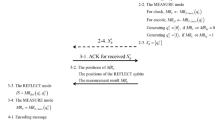Abstract
Recently, Zou and Qiu (Sci China Phys Mech Astron 57:1696–1702, 2014) proposed a three-step semi-quantum secure direct communication protocol allowing a classical participant who does not have a quantum register to securely send his/her secret message to a quantum participant. However, this study points out that an eavesdropper can use the double C-NOT attack to obtain the secret message. To solve this problem, a modification is proposed.

Similar content being viewed by others
Explore related subjects
Discover the latest articles, news and stories from top researchers in related subjects.References
Bennet, C.H., Brassard, G.: Quantum cryptography: public key distribution and coin tossing. In: Proceedings of the IEEE International Conference on Computers, Systems and Signal Processing, Bangalore, India, pp. 175–179 (1984)
Boyer, M., Kenigsberg, D., Mor, T.: Quantum key distribution with classical Bob. Phys. Rev. Lett. 99, 140501 (2007)
Boyer, M., Gelles, R., Kenigsberg, D., Mor, T.: Semiquantum key distribution. Phys. Rev. A 79(3), 032341 (2009)
Zou, X., Qiu, D., Li, L., Lihua, W., Li, L.: Semiquantum-key distribution using less than four quantum states. Phys. Rev. A 79(5), 052312 (2009)
Li, Q., Chan, W.H., Long, D.-Y.: Semiquantum secret sharing using entangled states. Phys. Rev. A 82(2), 022303 (2010)
Boyer, M., Mor, T.: Comment on “Semiquantum-key distribution using less than four quantum states”. Phys. Rev. A 83(4), 046301 (2011)
Jian, W., Sheng, Z., Quan, Z., Chao-Jing, T.: Semiquantum key distribution using entangled states. Chin. Phys. Lett. 28(10), 100301 (2011)
Wang, J., Zhang, S., Zhang, Q., Tang, C.-J.: Semiquantum secret sharing using two-particle entangled state. Int. J. Quantum Inf. 10(05), 1250050 (2012)
Krawec, W.O.: Mediated semiquantum key distribution. Phys. Rev. A 91(3), 032323 (2015)
Chou, W.-H., Hwang, T., Gu, J.: Semi-quantum private comparison protocol under an almost-dishonest third party, arXiv preprint arXiv:1607.07961 (2016)
Yu, K.-F., Gu, J., Hwang, T., Gope, P.: Multi-party semi-quantum key distribution-convertible multi-party semi-quantum secret sharing. Quantum Inf. Process. 16(8), 194 (2017)
Zou, X., Qiu, D.: Three-step semiquantum secure direct communication protocol. Sci China Phys Mech Astron 57(9), 1696–1702 (2014)
Deng, F.-G., Long, G.L., Liu, X.-S.: Two-step quantum direct communication protocol using the Einstein–Podolsky–Rosen pair block. Phys. Rev. A 68(4), 042317 (2003)
Deng, F.-G., Long, G.L.: Secure direct communication with a quantum one-time pad. Phys. Rev. A 69(5), 052319 (2004)
Liu, Z.-R., Hwang, T.: Mediated semi-quantum key distribution without invoking quantum measurement. Ann. Phys. 530(4), 1700206 (2018)
Zhang, M.-H., Li, H.-F., Peng, J.-Y., Feng, X.-Y.: Fault-tolerant semiquantum key distribution over a collective-dephasing noise channel. Int. J. Theor. Phys. 56(8), 2659–2670 (2017)
Acknowledgements
We would like to thank the Ministry of Science and Technology of Republic of China for financial support of this research under Contract No. MOST 105-2221-E-006-162-MY2. Special thank is due to the anonymous reviewer for his/her suggestion on the use of delay lines to avoid the double C-NOT attack.
Author information
Authors and Affiliations
Corresponding author
Rights and permissions
About this article
Cite this article
Gu, J., Lin, Ph. & Hwang, T. Double C-NOT attack and counterattack on ‘Three-step semi-quantum secure direct communication protocol’. Quantum Inf Process 17, 182 (2018). https://doi.org/10.1007/s11128-018-1953-3
Received:
Accepted:
Published:
DOI: https://doi.org/10.1007/s11128-018-1953-3




